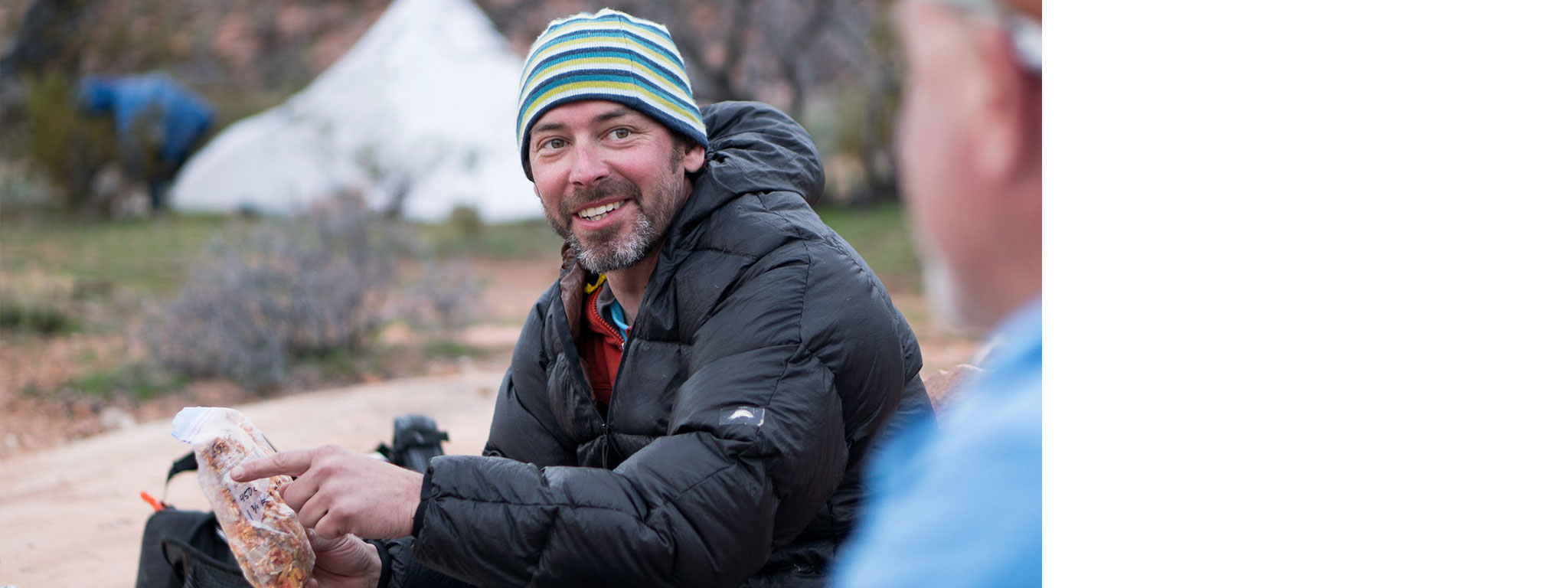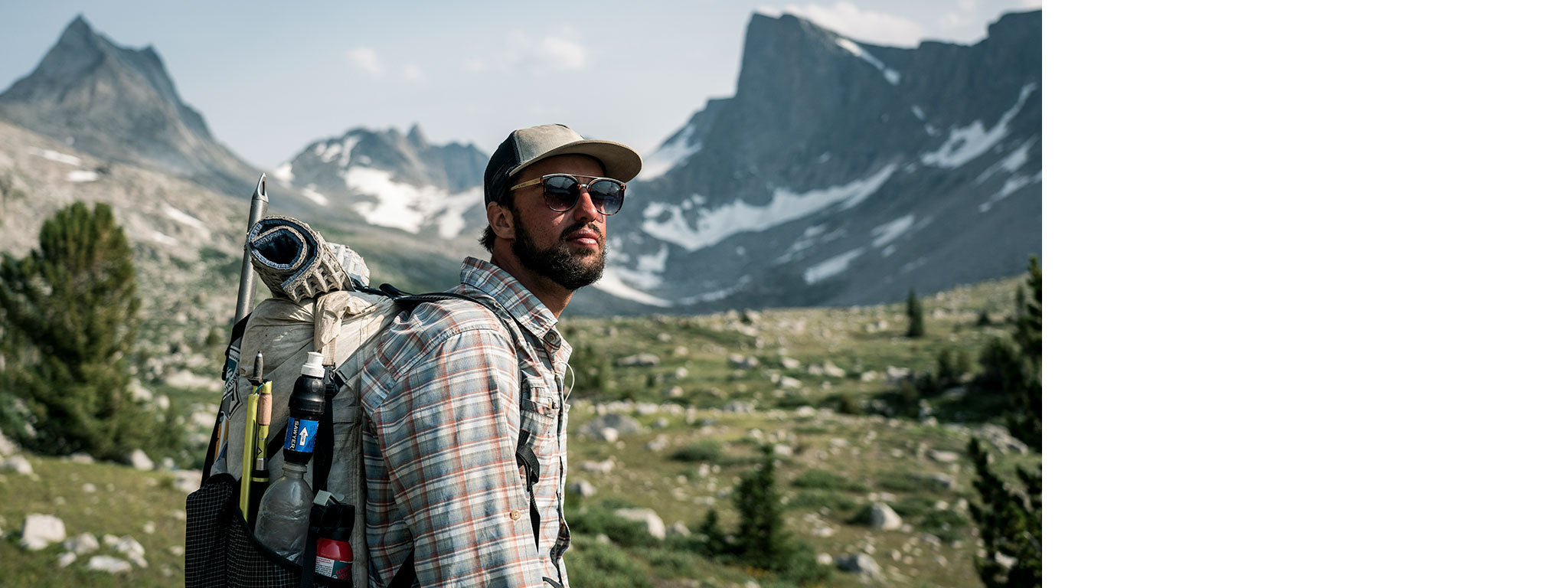THE SHAKEDOWN – 08: HYDRATION VESSELS
April 15, 2019
Water, water everywhere, and not a drop to drink? Not likely. There are myriad ways to ensure that if there’s some of that precious liquid around, you’ll be able to safely gulp it down. There are pump filters, gravity filters, squeeze filters, UV Pens, treatment tablets, and/or drops. How much time do you have? How physical do you want to get? How much is taste an issue? How many people do you travel with? Let’s dive in.

MIKE ST. PIERRE
HYPERLITE MOUNTAIN GEAR // CO-FOUNDER + CEO
You have several options here. There are pump filters, gravity filters, Sawyer Squeeze Filters, UV Pens, treatment tablets, and/or drops. I’m not a fan of any filter. I’ve used them for much of my adventuring, and at some point, the filter will clog when it’s least expected. The latest and greatest in water treatment is the Aqua Mira drop treatment system. This is a two-part system that comes in two separate bottles. You mix 5 to 7 drops of each bottle together, wait 5 minutes, and then add the mixture to your untreated water. Wait 20 minutes more or so, and your water is good to go. There is no taste or odor associated with this system, and it’s the most foolproof treatment yet. If your water source has a lot of sediment, algae, or bugs, run the water through your shirt, hat, or a bandana as a filter, and then treat it with the drops.
“Dave and I collected untreated water from the spring while Chris elected to wait. It was a fateful mistake. Later, Dave and I would both develop giardia complements of the Dragon Creek beaver that was busy at work making a new dam after a flood blew the old one away.” // Rich Rudow
The UV pens are cool, reasonably light, and work, but again, it does not filter your water, and the drawback is it requires batteries. Another consideration is the glass tube through which the UV light is emitted. I’ve seen one drop on a trip and shatter rendering the pen useless.
You see more and more Sawyer Squeeze filters on the big trails, and I’ve always wondered why as I watch users struggling to squeeze water out of their bladder or bottle into a clean bottle or bladder. Not to mention, the filter cartridge needs to be replaced regularly – something I find most people do not do in a timely fashion. One more drawback to lots of filters is they cannot freeze as this could crack the ceramic filter inside.

KURT REFSNIDER
GEOLOGY PROFESSOR // ENDURANCE BIKEPACKER // BIKEPACKINGROOTS.ORG
On any long endeavor, whether it’s a big day or a month-long tour, you’ll probably drink a lot of water. You might need water for cooking or an afternoon pick-me-up coffee. And you obviously won’t be carrying gallons of water in most circumstances. Luckily, there’s ample surface water scattered about most landscapes, so you don’t have to feel like a camel carrying enough potable water to get you to the next town. You just need a way to treat the surface water so you can safely fill your bottles and drink up.
The reality is that there’s no perfect single method for treating drinking water. Some water comes straight out of the ground at springs and doesn’t even need to be treated, whereas many other water sources are filled with harmful microorganisms, may be brown with silt, might smell like manure, or could be green with algae. Whether or not the water source sounds (or smells) at all appetizing, it can safely be consumed if properly treated. But if you fail to adequately treat it, you may suffer the unfortunate consequences a week or more down the trail as giardia, parasites, or other nasty bugs find a new home in your gut. Here are a few different commonly-used approaches to water treatment and some of their pros and cons with bikepacking/backcountry travel in mind. I also share my favorite approach for making the cloudiest of water virtually clear with nothing more than alum powder.
Boiling: This is the traditional treatment method, but there’s no need to bring the water to a rolling boil for 10 minutes like you may have been instructed as a kid. Bringing the water up to a boil is sufficient, and this is a great way to treat water that you use for cooking or hot drinks since you’ll need to warm it up anyway. But boiling all your drinking water takes both time and fuel, so it’s not a great universal approach.
Filtering: There is a plethora of relatively small water filters on the market, but most are on the heavy and bulky side. Lighter filters like the Sawyer Mini and Sawyer 4-in-1 Inline are excellent and rather inexpensive options for chemical-free water treatment. Both of these options can be inserted right into a hydration bladder hose, or as squeeze or gravity filters to fill something like a bottle with filtered water. The MSR TrailShot is a fist-sized pump-action filter that I’ve had good success with. The downsides to filters like these is that they shouldn’t be allowed to freeze and that they clog up relatively quickly with murky water. Regular backflushing helps clear particulates out of the filter, but even with this, the lifespan of filters, in my experience, is nowhere near what companies seem to claim if you don’t exclusively filter crystal-clear water.
Chemical treatment: Iodine drops or tablets, chlorine dioxide tablets, and Aqua Mira (a two-part solution that creates a chlorine solution when mixed) are all reliable, light, and simple water treatment methods. Iodine adds a strong flavor to water, whereas chlorine dioxide and Aqua Mira tend to be less noticeable. Aqua Mira allows you to add as much or little solution as you deem necessary – 7 drops per liter for questionable/murky water or just a few drops for relatively clean water. And the longer you let the chemical do its job before drinking, the more effective the treatment; for Aqua Mira, a minimum of 20 minutes is required. Note that chlorine dioxide is much less reliable for water that is filled with organic material (like algae), and you should never put any drink mix into the water until after it is done being treated.
Ultraviolet radiation: UV devices like a Steripen can be a good solution, but they rely on batteries and are not particularly effective in murky water. And treating water 0.5 or 1 liter at a time with a UV device can be quite time-consuming, especially along mosquito-infested shorelines. Always carry back-up batteries and a back-up treatment method.
Dealing with silty water – magic with alum powder: In some parts of the country, you’re often stuck filling your bottles with thick, brown, sandpaper-like water. It’s not appetizing, it’s not even close to clear, and it probably will crunch between your teeth. This sort of water will kill your filter and is too cloudy for a UV device to work. But never fear (or refuse to drink what looks like chocolate milk but is nowhere nearly as refreshing)! You can pre-filter this water through a bandana, or you can get really crafty and carry along some alum powder. Alum is a white powder used in the process of dying fabrics, and conveniently, it’s available in the spice section of most larger grocery stores. But alum has a little-known trick up its sleeve – it is incredibly effective at helping settle silt and clay particles out of water. Mix up few ounces of clean and ideally warm water with ~1 tablespoon of alum, allow it to dissolve as much as possible, and then add that to 1 gallon of your brown water. Within 20 minutes, the alum powder will have bound to the sediment and caused it to sink to the bottom, yielding astoundingly clear water. Now you can carefully pour off or scoop out the clear water and treat/filter it for drinking. Carrying a small collapsible bucket or a crushed plastic gallon jug works well for the settling process.
All these water treatment methods will get you clean water that will keep you from getting sick so long you follow any specific directions and are careful to avoid cross-contaminating anything with untreated water. My preference these days is to carry an in-line filter and Aqua Mira, using the latter for dirtier water and the filter for clearer water.

BETHANY "FIDGIT" HUGHES
THRU HIKER // WORLD TRAVELER // HER-ODYSSEY.ORG
Water sources are incredibly varied. We have drunk water flowing straight off a glacier, which we saw no reason to treat. But walking through Peru and Ecuador, where many of our water sources were downstream of farms using heavy pesticides, we used the Sawyer Select S3 both to neutralize the taste as well as all the little monsters in the water.

KRYSTIAN "SNAP" REPOLONA
THRU HIKER // PHOTOGRAPHER // @HIKES.CAMERA.ADVENTURE
The Sawyer Squeeze threads onto my SmartWater bottle and Platypus water carrying system and I use Aquamira Water Treatment drops as my back-up water treatment system for Sawyer Squeeze. The Sawyer could be potentially unusable or no longer effective if it freezes or you lose its o-ring.

NICK "CLICK" REICHARD
THRU HIKER // PHOTOGRAPHER // @NICHOLASREICHARD
This is one of those things that seems difficult to give advice for. What works for me may not work for someone else. However, after hiking over 6,000 miles, I used a full Sawyer Squeeze with 1 L SmartWater bottles. On the AT, I was able to get away with carrying just two 1 L bottles, but out west, on the PCT and CDT, I carried 4 1 L bottles as well as a 2.5 L Platypus collapsible water bladder.

JESSICA KELLEY
BIKEPACKER // PACKRAFTER // @JESSI_GOES
I love Aquatabs. Fast, easy, and they don’t taste too bad.

LIZ "HANDSTAND" KIDDER
THRU HIKER // WORLD TRAVELER // @LIZKIDDER
I used the Sawyer Squeeze (32oz) filter system. Easy to use, not too time consuming, not too expensive, fits on everything – what more do you want out of a water filter? Compared to tablets, the water tastes normal and you can drink it immediately. The regular/32-oz size does not clog very easily (compared to the mini)– and I only had to backwash it a handful of times on my thru hike. You can also use those fancy SmartWater bottle tops as your backwash for the Sawyer instead of carrying the extra syringe that comes with it. Only thing to watch out for: you can’t let the filter freeze, so you have to sleep with them on cold nights or carry in your pocket on very cold days!

EDDIE "OILCAN" BOYD
THRU HIKER // TRIPLE CROWNER // @OC_BOYD
The big Sawyer Squeeze filter all day, every day. Screw that onto a one-liter SmartWater bottle and you’re good to go!

YOUR CART IS EMPTY
Let’s find you the right gear for
your next adventure.